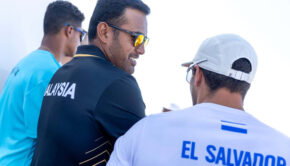Improving onboard communication
Published on August 11th, 2021
Bary B. Gately, a sail designer and professional coach, shares tips on how communication within the crew translates to performance on the race course:
For some boats there needs to be less chatter and a focus on only pertinent information to be expressed, while for others, the crew needs to speak up when they have a good observation or have needs that have to be addressed.
Most of us are all too familiar with the problems of too much, confusing, or incomplete information on boats. One of the tools I give my students is that all communication needs to pass the “Newspaper Editor Test”: does it convey who, what, when and where?
Who
Try to always address an individual for specific tasks. This way you know you are getting the attention of the desired person and not distracting the entire crew as well. If possible make eye contact before continuing.
What
Be as specific as possible in the desired request and use quantitative increments if possible. A random request to “Ease the guy” will probably not be fulfilled as quickly as “Sam…Ease the guy forward one foot…That’s good, thank you.”
When
While specific task requests may be for immediate attention, there is a lot of communication regards wind, waves, other boats, etc that come under the category of “F.Y.I” and are future orientated. To alert everyone to the proximity of the event it helps to use increments such as seconds or boat lengths. “Puff ahead” is not nearly as specific or useful as “Puff in 10 seconds…Puff in 5…Puff in 2…Puff on now.”
Where
Want to see the blood pressure of our typical boat owner/driver/skipper soar through the roof? With a minute to go in any starting sequence just nonchalantly call out: “Boat ahead, he’s on Starboard” and the say nothing more. Look back and watch the fun ensue as the afterguard scrambles to find the potential threat – forgetting for the moment that they are on starboard as well!
If you want to prevent afterguard meltdowns make sure to accurately “paint a picture” of the situation developing. “Got a dark blue boat on Starboard crossing in 30 seconds, you can see him under your boom, looks like he has us clean, no duck…He will cross by a length in 10 seconds, no duck, go fast…you will see him on your headstay in 5 seconds, no duck, go fast.”
While nobody likes to get crossed, in this situation we accurately appraised the threat as low and kept our priorities in order; i.e. to go fast and not get distracted by their presence.
There are infinite possibilities on the racecourse so it will take practice to run each of your vocalizations through this filter every time you go to speak, but the result is that every time you open your mouth people will listen. They will come to expect clarity not confusion from you.
For all you “crew-bosses” out there, the pleasant surprise is that in the time it takes you to reframe your command you will find most of the time your crew has recognized the error or problem and begun steps to correct it. Having self-corrected, it will be an error they will not repeat!
How and Why
I leave these out of racecourse communication because these should be discussed and understood during practice sessions. Admittedly we all sail with an assortment of experience on our boats, but race time is typically not a good ‘teaching time’. Hopefully your more experienced crew will be looking out for the newcomers and keeping them out of trouble before it happens.
Communication and Teambuilding
Whenever I hop onto a boat for a seminar one of the first things I actively do is listen. How does the crew talk amongst themselves? Does it sound emotional or matter of fact and business like? Are the comments pertinent? Are comments or requests acknowledged? Does the crew understand the distinction between volume and content?
Basically what I am finding out is how do they treat each other and are they being given the autonomy to be fully engaged and to take self initiative. I am typically correct that the loud and chaotic boats are full of crew new to each other simply because there is such a high attrition rate throughout each season and that the calmer, quieter boats have crews that have been sailing together with a low turn-over rate.
When we take the time to learn to communicate calmly, clearly, and succinctly we are showing respect to our teammates. That respect is the beginnings of building trust and reinforcing the positive attitude of the members. As these elements begin to manifest themselves amongst the individuals you will find that you have created the synergy necessary for a team.
No matter how hard we try, we are going to make communication mistakes! It may be a raised voice from tension of the situation or the insecurity of trying something new, it may be a sarcastic comment caused by frustration; any number of things may cause us to lose our cool.
The best way to restore your teammates respect is by respecting them first. At an appropriate time, usually during the post-race debrief acknowledge that you snapped and that you were sorry. It doesn’t have to be elaborate, just sincere and your crewmates will give you the benefit of the doubt and accept you for being as human as they are.
Good positive communication will get you around the racecourse faster as we remain focused on priorities while learning to ignore minor distractions and it will help keep your team together longer.
If you have a communication problem on your boat then be like the newspaper editor and work with them to start formulating everything within the “Who, What, When and Where” context. I think you will find that the quantity of chatter decreases but the quality increase of information is expediential!








 We’ll keep your information safe.
We’ll keep your information safe.